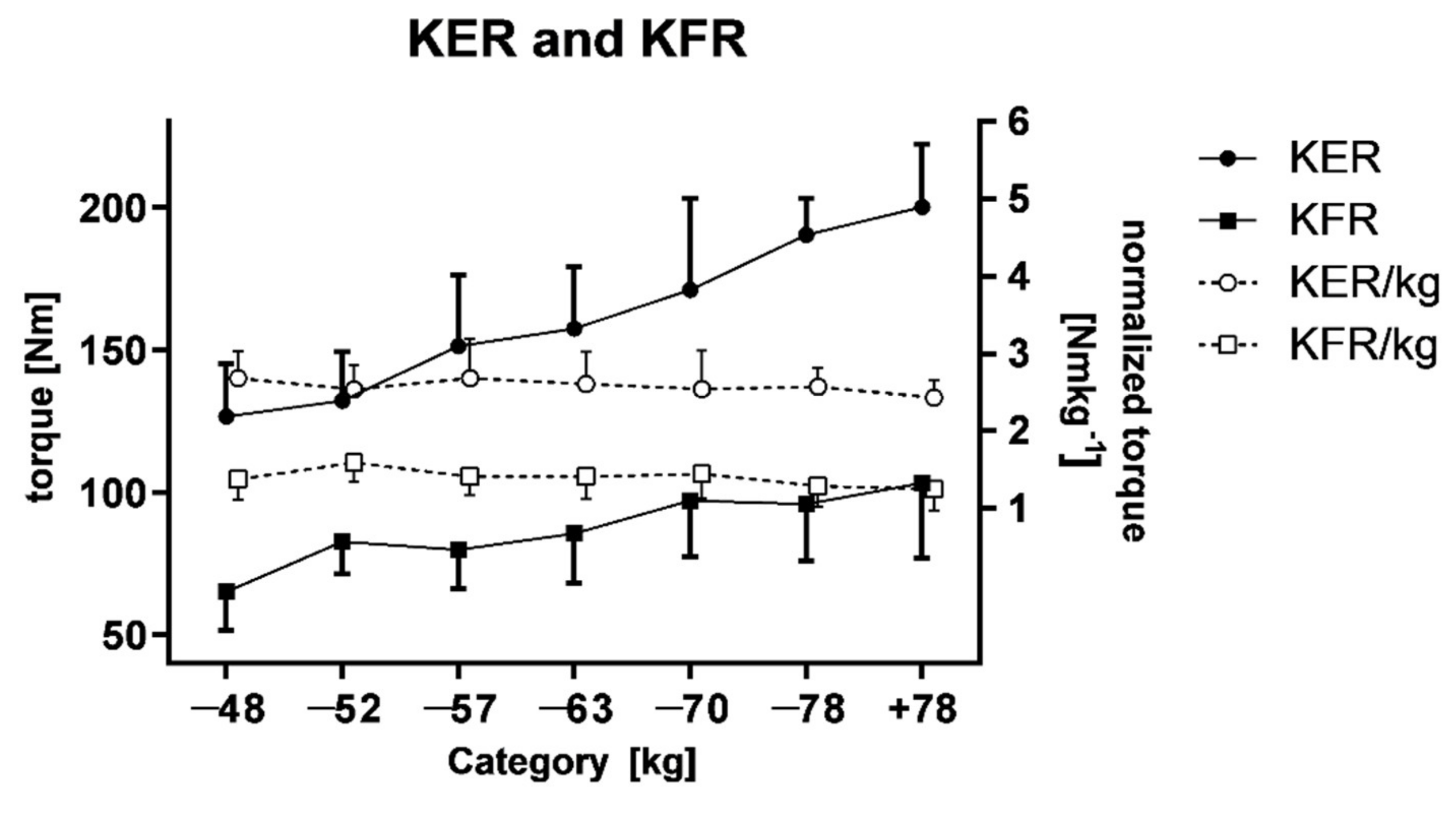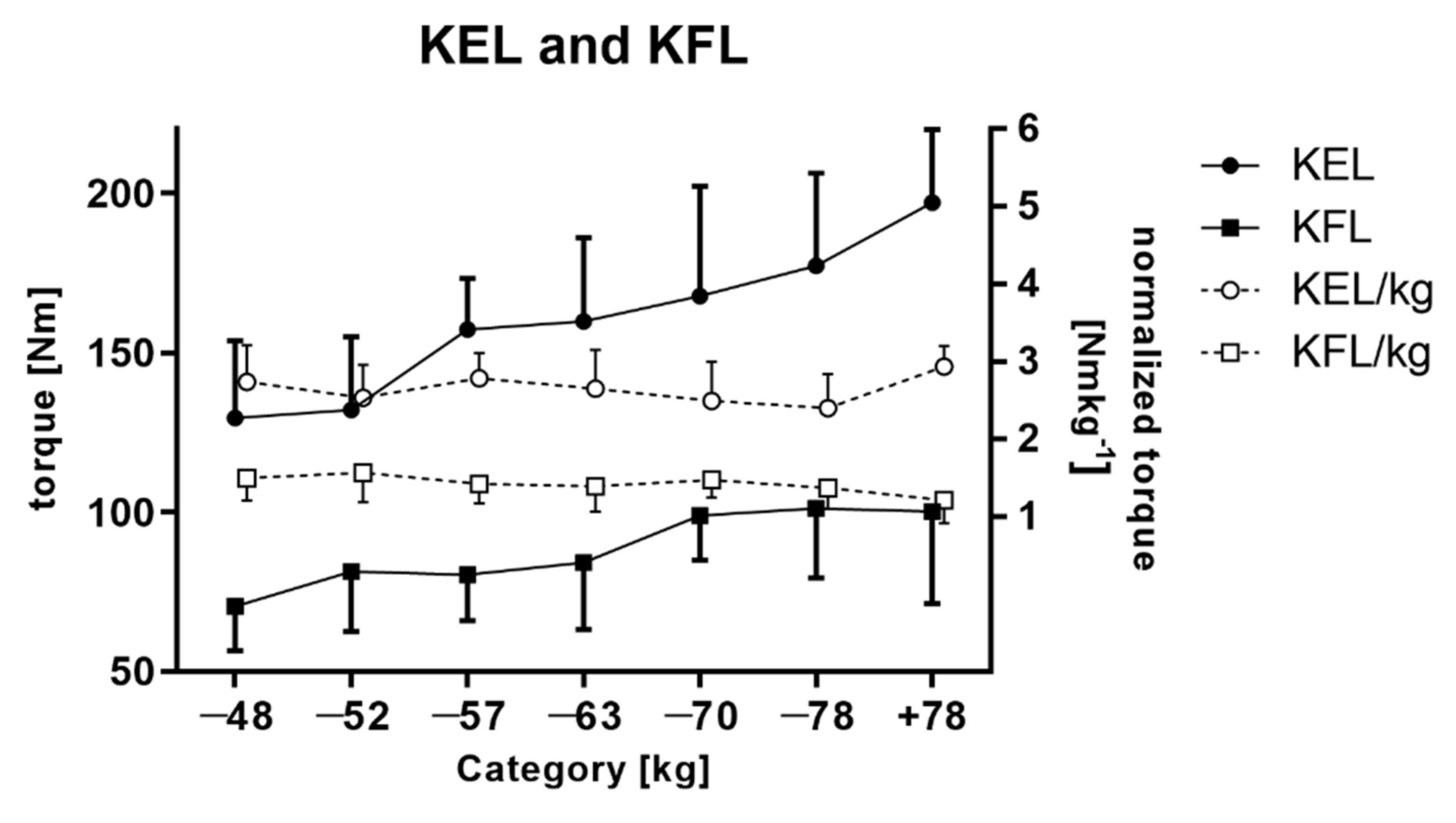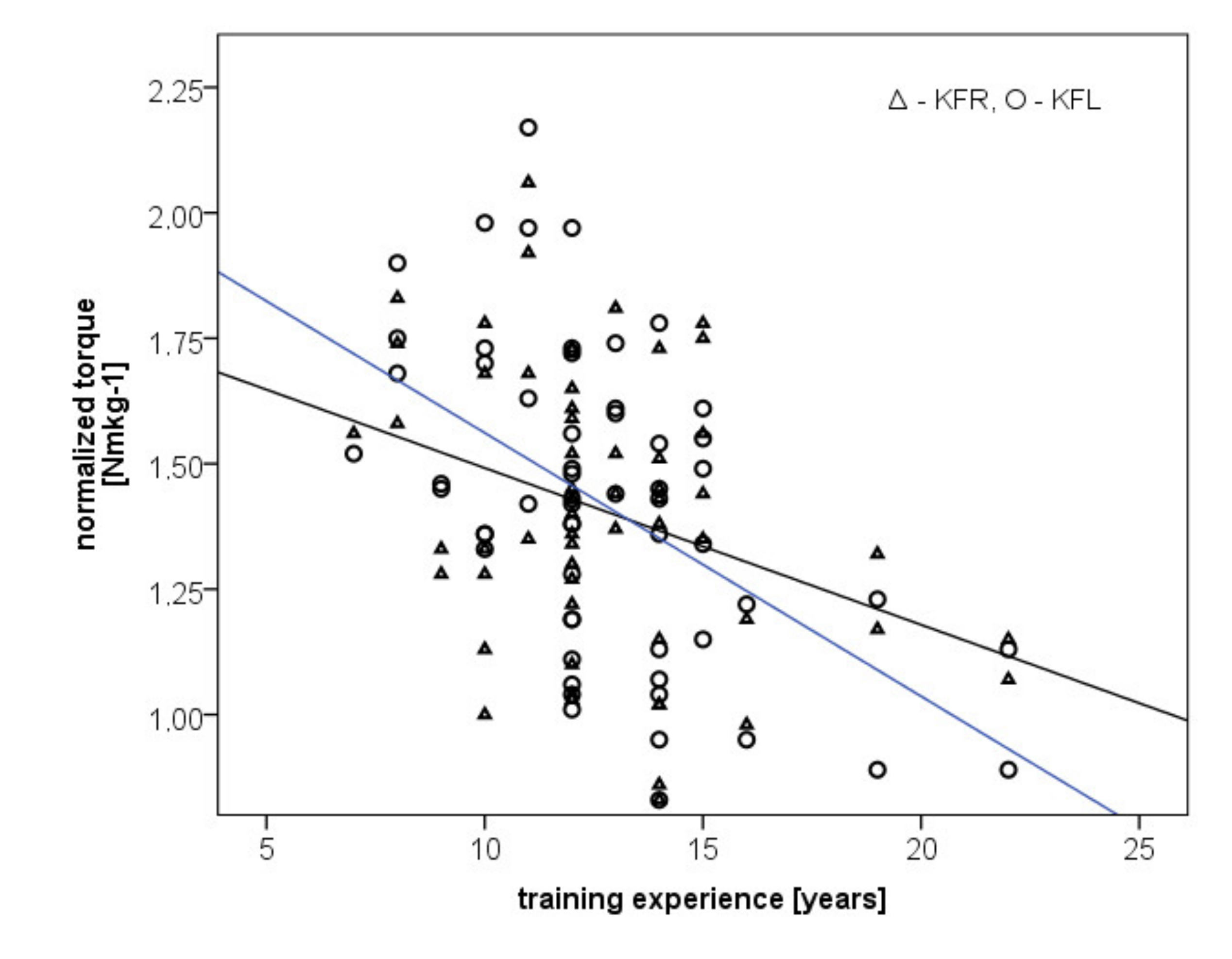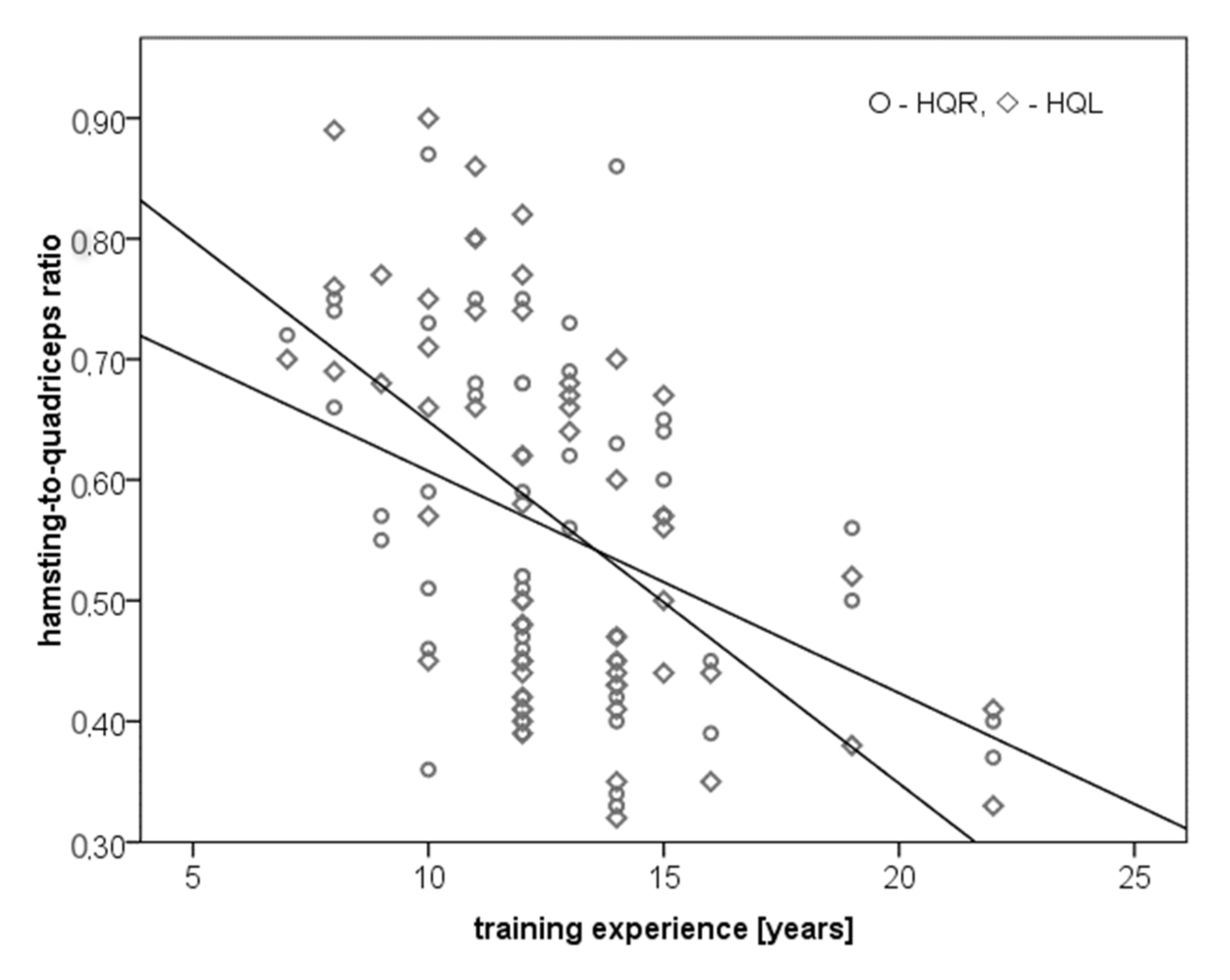Isokinetic Profile of Elite Serbian Female Judoists
Abstract
:1. Introduction
2. Materials and Methods
2.1. Sample
2.2. Experimental Procedure and Data Analysis
2.3. Statistical Analysis
3. Results
4. Discussion
5. Conclusions
Author Contributions
Funding
Institutional Review Board Statement
Informed Consent Statement
Data Availability Statement
Conflicts of Interest
References
- Sands, W.A.; Kavanaugh, A.A.; Murray, S.R.; McNeal, J.R.; Jemni, M. Modern techniques and technologies applied to training and performance monitoring. Int. J. Sports Physiol. Perform. 2017, 12, S2-63–S2-73. [Google Scholar] [CrossRef] [PubMed] [Green Version]
- Gabbett, T.J. The training-injury prevention paradox: Should athletes be training smarter and harder? Br. J. Sports Med. 2016, 50, 273–280. [Google Scholar] [CrossRef] [Green Version]
- Le Masurier, G.C.; Lambdin, D.; Corbin, C.C. Fitness for Life: Middle School; Human Kinetics: Champaign, IL, USA, 2007. [Google Scholar]
- Franchini, E.; Takito, M.Y.; Kiss, M.A.P.D.M.; Sterkowicz, S. Physical fitness and anthropometrical differences between elite and non-elite judo players. Biol. Sport. 2005, 22, 315–328. [Google Scholar]
- Trivic, T.; Drid, P.; Obadov, S. Aerobic capacity of male judokas in comparison with university students of the Faculty of Sport and Physical Education. Arch. Budo 2009, 5, 143–146. [Google Scholar]
- Drid, P.; Casals, C.; Mekic, A.; Radjo, I.; Stojanovic, M.; Ostojic, S.M. Fitness and anthropometric profiles of international vs. national judo medalists in half-heavyweight category. J. Strength Cond. Res. 2015, 29, 2115–2121. [Google Scholar] [CrossRef] [PubMed]
- Ortega, F.B.; Ruiz, J.R.; Castillo, M.J.; Sjöström, M. Physical fitness in childhood and adolescence: A powerful marker of health. Int. J. Obes. 2008, 32, 1–11. [Google Scholar] [CrossRef] [Green Version]
- Zebrowska, A.; Trybulski, R.; Roczniok, R.; Marcol, W. Effect of physical methods of lymphatic drainage on postexercise recovery of mixed martial arts athletes. Clin. J. Sport Med. 2019, 29, 49–56. [Google Scholar] [CrossRef]
- Fiskerstrand, A.; Seiler, K.S. Training and performance characteristics among Norwegian international rowers 1970–2001. Scand. J. Med. Sci. Sports 2004, 14, 303–310. [Google Scholar] [CrossRef] [Green Version]
- Franchini, E.; Artioli, G.G.; Brito, C.J. Judo combat: Time-motion analysis and physiology. Int. J. Perform. Anal. Sport 2013, 13, 624–641. [Google Scholar] [CrossRef]
- Franchini, E.; Brito, C.J.; Fukuda, D.H.; Artioli, G.G. The physiology of judo-specific training modalities. J. Strength Cond. Res. 2014, 28, 1474–1481. [Google Scholar] [CrossRef] [PubMed]
- Baltzopoulos, V.; Brodie, D.A. Isokinetic dynamometry: Applications and limitations. Sports Med. 1989, 8, 101–116. [Google Scholar] [CrossRef] [PubMed]
- Knuttgen, H.; Nordesjö, L.; Ollander, B.; Saltin, B. Physical conditioning through interval training with young male adults. Med. Sci. Sports Exerc. 1973, 5, 220–226. [Google Scholar] [CrossRef]
- Ireland, M. The female ACL: Why is it more prone to injury? Orthop. Clin. N. Am. 2002, 33, 637–651. [Google Scholar] [CrossRef] [Green Version]
- Koshida, S.; Deguchi, T.; Miyashita, K.; Iwai, K.; Urabe, Y. The common mechanisms of anterior cruciate ligament injuries in judo: A retrospective analysis. Br. J. Sports Med. 2010, 44, 856–861. [Google Scholar] [CrossRef]
- Busnel, F.; Rochcongar, P.; Andre, A.M.; Beillot, J.; Jan, J. Exploration isocinétique du genou du judoka et risque de rupture du LCA. À propos d’une enquête prospective auprès des athlètes du pôle France de Rennes. Sci. Sports 2006, 21, 148–153. [Google Scholar] [CrossRef]
- Bien, D.P. Rationale and implementation of anterior cruciate ligament injury prevention warm-up programs in female athletes. J. Strength Cond. Res. 2011, 25, 271–285. [Google Scholar] [CrossRef] [PubMed] [Green Version]
- Dugan, S.A. Sports-related knee injuries in female athletes: What gives? Am. J. Phys. Med. Rehabil. 2005, 84, 122–130. [Google Scholar] [CrossRef] [PubMed]
- Voskanian, N. ACL Injury prevention in female athletes: Review of the literature and practical considerations in implementing an ACL prevention program. Curr. Rev. Musculoskelet. Med. 2013, 6, 158–163. [Google Scholar] [CrossRef] [PubMed] [Green Version]
- Lephart, S.M.; Ferris, C.M.; Riemann, B.L.; Myers, J.B.; Fu, F.H. Gender differences in strength and lower extremity kinematics during landing. Clin. Orthop. Relat. Res. 2002, 401, 162–169. [Google Scholar] [CrossRef]
- Buchanan, P.A.; Vardaxis, V.G. Lower-extremity strength profiles and gender-based classification of basketball players ages 9–22 years. J. Strength Cond. Res. 2009, 23, 406–419. [Google Scholar] [CrossRef]
- Hewett, T.E.; Lindenfeld, T.N.; Riccobene, J.V.; Noyes, F.R. The effect of neuromuscular training on the incidence of knee injury in female athletes. A prospective study. Am. J. Sports Med. 1999, 27, 699–706. [Google Scholar] [CrossRef] [PubMed]
- Brophy, R.H.; Silvers, H.J.; Mandelbaum, B.R. Anterior cruciate ligament injuries: Etiology and prevention. Sports Med. Arthrosc. 2010, 18, 2–11. [Google Scholar] [CrossRef] [PubMed]
- Trajkovic, N.; Madic, D.; Maksimovic, N.; Milosevic, Z.; Obradovic, B.; Trivic, T.; Drapsin, M.; Drid, P. Knee and shoulder strength ratios in female karate athletes: Age-related differences. Med. Sport 2019, 72, 191–199. [Google Scholar]
- Malovic, P.; Bjelica, D.; Atanasov, D.; Trivic, T.; Drapsin, M.; Trajkovic, N.; Maksimovic, N.; Drid, P. Knee strength ratios in male judokas: Age-related differences. Arch. Budo 2020, 16, 43–52. [Google Scholar]
- Harris, D.; Foulds, S.; Latella, C. Evidence-based training recommendations for the elite judoka. Strength Cond. J. 2018, 41, 108–118. [Google Scholar] [CrossRef]
- Pocecco, E.; Ruedl, G.; Stankovic, N.; Sterkowicz, S.; Del Vecchio, F.B.; Gutiérrez-García, C.; Rousseau, R.; Wolf, M.; Kopp, M.; Miarka, B.; et al. Injuries in judo: A systematic literature review including suggestions for prevention. Br. J. Sports Med. 2013, 47, 1139–1143. [Google Scholar] [CrossRef] [Green Version]
- Undheim, M.B.; Cosgrave, C.; King, E.; Strike, S.; Marshall, B.; Falvey, É.; Franklyn-Miller, A. Isokinetic muscle strength and readiness to return to sport following anterior cruciate ligament reconstruction: Is there an association? A systematic review and a protocol recommendation. Br. J. Sports Med. 2015, 49, 1305–1310. [Google Scholar] [CrossRef]
- Kostrzewa, M.; Laskowski, R.; Wilk, M.; Błach, W.; Ignatjeva, A.; Nitychoruk, M. Significant predictors of sports performance in elite men judo athletes based on multidimensional regression models. Int. J. Environ. Res. Public Health 2020, 17, 8192. [Google Scholar] [CrossRef]
- Drid, P.; Drapsin, M.; Trivic, T.; Lukac, D.; Obadov, S.; Milosevic, Z. Asymmetry of muscle strength in elite athletes. Biomed. Hum. Kinet. 2009, 1, 3–5. [Google Scholar] [CrossRef]
- Drid, P.; Ostojic, S.; Vujkov, S.; Purkovic, S.; Trivic, T.; Stojanovic, M. Physiological adaptations of a specific muscle-imbalance reduction training programme in elite female judokas. Arch. Budo 2011, 7, 61–64. [Google Scholar]
- Kons, R.L.; Junior, J.N.D.S.; Follmer, B.; Katcipis, L.F.G.; Almansba, R.; Detanico, D. Validity of judo-specific tests to assess neuromuscular performance of judo athletes. Sports Biomech. 2021, 20, 178–189. [Google Scholar] [CrossRef] [PubMed]
- Andrade, M.D.S.; De Lira, C.A.B.; Koffes, F.D.C.; Mascarin, N.C.; Benedito-Silva, A.A.; Da Silva, A.C. Isokinetic hamstrings-to-quadriceps peak torque ratio: The influence of sport modality, gender, and angular velocity. J. Sports Sci. 2012, 30, 547–553. [Google Scholar] [CrossRef] [PubMed]




| Variable | −48 kg (n = 8) | −52 kg (n = 8) | −57 kg (n = 8) | −63 kg (n = 9) | −70 kg (n = 8) | −78 kg (n = 8) | +78 kg (n = 9) | Statistics |
|---|---|---|---|---|---|---|---|---|
| Height (cm) | 148.50 ± 1.61 | 160.00 ± 2.41 | 163.57 ± 4.87 a | 166.12 ± 4.54 a | 169.57 ± 11.22 a | 172.10 ± 8.77 a | 174.54 ± 6.56 a | F = 5.42, p = 0.001, η2 = 0.522 |
| Weight (kg) | 47.12 ± 1.80 | 52.00 ± 1.80 a | 56.62 ± 2.06 a, b | 60.55 ± 1.87 a, b, c | 67.25 ± 1.98 a, b, c, d | 74.16 ± 3.12 a, b, c, d, e | 82.11 ± 4.25 a, b, c, d, e, f | F = 204.75, p = 0.000, η2 = 0.960 |
| Age (y) | 20.62 ± 1.92 | 19.90 ± 3.24 | 21.25 ± 2.96 | 22.77 ± 4.99 | 19.75 ± 2.65 | 21.00 ± 2.45 | 21.01 ± 3.10 | F = 1.047, p = 0.410, η2 = 0.109 |
| Training experience (y) | 12.12 ± 2.53 | 12.10 ± 4.28 | 13.25 ± 1.38 | 14.88 ± 5.56 | 11.12 ± 1.12 | 12.16 ± 1.94 | 13.11 ± 1.36 | F = 1.470, p = 0.207, η2 = 0.147 |
| Variable | −48 kg (n = 8) | −52 kg (n = 8) | −57 kg (n = 8) | −63 kg (n = 9) | −70 kg (n = 8) | −78 kg (n = 8) | +78 kg (n = 9) | Statistics |
|---|---|---|---|---|---|---|---|---|
| Mean Torque | ||||||||
| KER (Nm) | 126.50 ± 18.36 | 132.00 ± 17.13 | 151.25 ± 24.92 | 157.33 ± 21.63 | 171.00 ± 32.08 a, b | 190.33 ± 12.78 a, b, c | 200.11 ± 22.03 a, b, c, d | F = 13.074, p = 0.000, η2 = 0.33 |
| KEL (Nm) | 129.37 ± 24.28 | 131.90 ± 22.98 | 157.12 ± 16.00 | 159.66 ± 26.19 | 167.62 ± 34.47 | 177.16 ± 29.06 a, b | 197.00 ± 22.94 a, b, c, d | F = 7.738, p = 0.000, η2 = 0.27 |
| KFR (Nm) | 65.12 ± 13.46 | 82.70 ± 11.48 | 79.87 ± 13.72 | 85.44 ± 17.57 | 97.12 ± 19.65 a | 95.83 ± 20.03 a | 102.88 ± 26.63 a | F = 4.088, p = 0.002, η2 = 0.53 |
| KFL (Nm) | 70.37 ± 13.93 | 81.20 ± 18.83 | 80.25 ± 14.42 | 84.00 ± 20.88 | 98.75 ± 13.76 | 101.33 ± 21.92 | 101.22 ± 28.30 a | F = 3.086, p = 0.012, η2 = 0.24 |
| Normalized Torque | ||||||||
| KER/kg (Nmkg−1) | 2.68 ± 0.35 | 2.53 ± 0.31 | 2.68 ± 0.49 | 2.60 ± 0.41 | 2.54 ± 0.49 | 2.57 ± 0.24 | 2.43 ± 0.22 | F = 0.458, p = 0.836, η2 = 0.051 |
| KEL/kg (Nmkg−1) | 2.74 ± 0.47 | 2.53 ± 0.42 | 2.78 ± 0.32 | 2.64 ± 0.50 | 2.49 ± 0.50 | 2.39 ± 0.43 | 2.39 ± 0.26 | F = 1.054, p = 0.402, η2 = 0.110 |
| KFR/kg (Nmkg−1) | 1.37 ± 0.26 | 1.59 ± 0.24 | 1.41 ± 0.23 | 1.41 ± 0.29 | 1.44 ± 0.31 | 1.29 ± 0.27 | 1.24 ± 0.27 | F = 1.535, p = 0.186, η2 = 0.153 |
| KFL/kg (Nmkg−1) | 1.49 ± 0.29 | 1.56 ± 0.38 | 1.41 ± 0.24 | 1.38 ± 0.32 | 1.47 ± 0.22 | 1.36 ± 0.27 | 1.22 ± 0.29 | F = 1.198, p = 0.323, η2 = 0.124 |
| Hamstring to quadriceps ratio | ||||||||
| HQR (%) | 0.52 ± 0.14 | 063 ± 0.10 | 0.54 ± 0.17 | 0.55 ± 0.16 | 0.58 ± 0.13 | 0.50 ± 0.12 | 0.51 ± 0.11 | F = 0.876, p = 0.519, η2 = 0.093 |
| HQL (%) | 0.56 ± 0.15 | 0.62 ± 0.14 | 0.51 ± 0.13 | 0.54 ± 0.20 | 0.61 ± 0.16 | 0.58 ± 0.17 | 0.51 ± 0.14 | F = 0.611, p = 0.720, η2 = 0.067 |
Publisher’s Note: MDPI stays neutral with regard to jurisdictional claims in published maps and institutional affiliations. |
© 2021 by the authors. Licensee MDPI, Basel, Switzerland. This article is an open access article distributed under the terms and conditions of the Creative Commons Attribution (CC BY) license (https://creativecommons.org/licenses/by/4.0/).
Share and Cite
Blach, W.; Drapsin, M.; Lakicevic, N.; Bianco, A.; Gavrilovic, T.; Roklicer, R.; Trivic, T.; Cvjeticanin, O.; Drid, P.; Kostrzewa, M. Isokinetic Profile of Elite Serbian Female Judoists. Int. J. Environ. Res. Public Health 2021, 18, 6988. https://doi.org/10.3390/ijerph18136988
Blach W, Drapsin M, Lakicevic N, Bianco A, Gavrilovic T, Roklicer R, Trivic T, Cvjeticanin O, Drid P, Kostrzewa M. Isokinetic Profile of Elite Serbian Female Judoists. International Journal of Environmental Research and Public Health. 2021; 18(13):6988. https://doi.org/10.3390/ijerph18136988
Chicago/Turabian StyleBlach, Wieslaw, Miodrag Drapsin, Nemanja Lakicevic, Antonino Bianco, Tamara Gavrilovic, Roberto Roklicer, Tatjana Trivic, Ognjen Cvjeticanin, Patrik Drid, and Maciej Kostrzewa. 2021. "Isokinetic Profile of Elite Serbian Female Judoists" International Journal of Environmental Research and Public Health 18, no. 13: 6988. https://doi.org/10.3390/ijerph18136988
APA StyleBlach, W., Drapsin, M., Lakicevic, N., Bianco, A., Gavrilovic, T., Roklicer, R., Trivic, T., Cvjeticanin, O., Drid, P., & Kostrzewa, M. (2021). Isokinetic Profile of Elite Serbian Female Judoists. International Journal of Environmental Research and Public Health, 18(13), 6988. https://doi.org/10.3390/ijerph18136988










